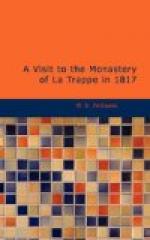“.......................... Voyez gemir en proie a sa longue torture, Ce mortel confine dans sa noire cloture. Pour unique plaisir et pour seul passe-temps, De sa lente journee il compte les instans, Ou de son noir cachot mesure l’etendue, Ou medite en secret sa fuite inattendue; Ou, de ceux qu’avant lui renferma la prison, Lit, sur ces tristes murs, la complainte et le nom: Et lui-meme y tracant sa douloureuse histoire, A ceux qui le suivront en transmet la memoire. C’est peu d’etre enchaine dans ces tristes tombeaux, Combien de souvenirs viennent aigrir ses maux! Helas! tandis qu’aupres de leurs jeunes compagnes; Dans les riches cites, dans les vastes campagnes; Ses amis d’autrefois errent en liberte, Lorsque l’heure propice a la societe, Reconduit chaque soir la jeunesse folatre Aux entretiens joyeux, a la danse, au theatre, Ou, d’un plaisir plus doux annoncant le retour, Du moment fortune vient avertir l’amour, Il est seul; ... en un long et lugubre silence, Pour lui le jour s’acheve, et le jour recommence; Il n’entend point l’accent de la tendre amitie, Il ne voit point les pleurs de la douce pitie: N’ayant de mouvement que pour trainer des chanes, Un coeur que pour l’ennui, des sens que pour les peines, Pour lui, plus de beaux jours, de ruisseau, de gazon; Cette voute est son ciel, ces murs son horizon, Son regard, eleve vers les flambeaux celestes, Vient mourir dans la nuit de ses cachots funestes; Rien n’egaie a ses yeux leur morne obscurite; Ou si, par des barreaux avares de clarte, Un faible jour se glisse en ces antres funebres, Il redouble pour lui les horreurs des tenebres, Et, le coeur consume d’un regret sans espoir, Il cherche la lumiere et gemit de la voir.”
DELILLE. CHATEAU DE SAINT GERMAIN.
This ancient pile of building is now a barrack for the King’s Gardes du Corps, containing two troops, one of Luxembourg, and the other of Grammont, which are relieved every three months.
It is supposed to have been built in the reign of Robert, but there appears to be no certainty as to the exact period. It is interesting to the English traveller, from having been the last refuge of James the Second of England, and the residence, at various times, of very celebrated and distinguished characters. It was taken, and pillaged, and partly burnt, during the reign of Philip VI, in 1346, by Edward the Third, and again by the English in 1419, and rebuilt by Francis the First. During the war of the League in 1574, Catherine de Medicis retired to this Castle, but from the predictions of an astrologer, that she would die there, quitted it shortly after, and returned to the Tuilleries, which Palace she had founded.[14] Henry the Fourth often frequented Saint Germain. The Chateau Neuf, and one of the towers, called Le Pavilion de Gabrielle, which is still in good preservation, were erected by him, close to the Castle, for the residence of his favourite, La belle Gabrielle:[15] and the superb terrace was begun in his reign. From this spot the view is very interesting and extensive: nothing can surpass the admirable assemblage of hills, meadows, gardens, and vineyards, which charm the eye, and which as they are viewed from its different points on a clear summer’s evening, appear at every turn, in new beauty, and endless variety.




